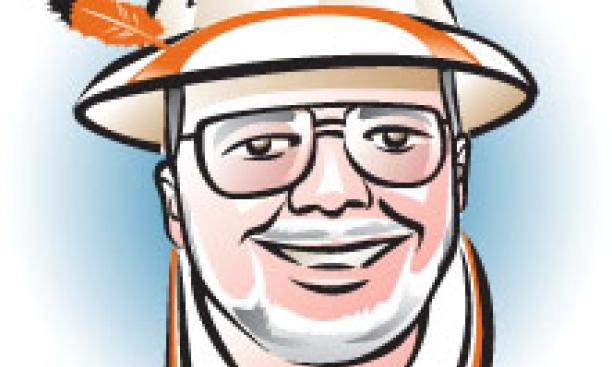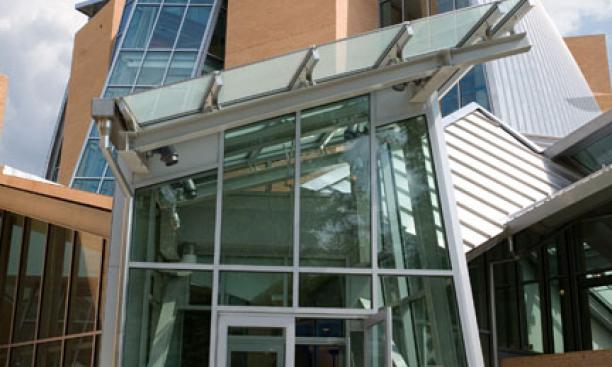

You would have to be pretty much brain-dead – even art history majors must have taken notice over their Frist Frappuccino – to miss the new Lewis Library thrusting up on Washington Road. Closer to the campus center and Prospect Street even than Firestone, it is intended as an alluring siren call to the science majors on campus, although that seems a disturbing concept when placed on paper (imagine that this is paper). Conjoined with the Fine Library that followed the math and physics departments down to the new Fine Hall/Jadwin Lab in 1969, it represents a giant step in the powerful commingling of the science resources on campus, much as the genomics and incipient neuroscience buildings represent a commingling of the traditionally discrete (if not discreet, which Frank Gehry certainly isn’t) branches of the natural sciences. This is such heady stuff, to those of us who were convinced Hubert Alyea ’24 and his exploding test tubes were the ultimate in scientific achievement, that we won’t even pause to reflect on the choice (it was conscious??) of brick for the Lewis façade.
The accumulation and cataloguing of scientific knowledge at Princeton goes back a lot further than 1969, of course, and has resided in many odd places, sometimes for many, many years. My personal favorite starting point is the fabled Rittenhouse Orrery – that’s not a typo, it’s not ornery like me, it’s an orrery – acquired through the good graces of good ol’ peripatetic Johnny Witherspoon when he wasn’t preaching, suspending rowdy students, or fomenting world revolution. He ordered the gear-driven working model of the planets from self-taught Philadelphia scientist David Rittenhouse (of Rittenhouse Square fame) in 1771, and it was the centerpiece of “natural philosophy,” i.e., science instruction, in Nassau Hall for decades. It’s still perking, in the lobby of the astrophysics department in Peyton Hall.
Of course, the whole formal library of the College resided in Nassau Hall until the fire of 1802, which eliminated the need for a tag sale to weed out the obsolete materials. Restarted in the new Stanhope Hall the next year, it returned to Nassau Hall in 1860 (after another fire). With the library now open one hour a week in a building that had been incinerated twice, one would assume the faculty would be prone to squirrel away important works in their own warrens outside the school, and one would be right. So in one sense, the “library” was about as concrete as Wikipedia.
The first documented offshoot of the official College Library outside the four (smoking) Nassau walls was in 1869, when the Halsted Observatory was built on University Place. The College’s astronomy collection and, more important, the private library of astronomy professor Stephen Alexander were gathered there as a natural part of the observatory’s working environment. This urge to collocate the scientific department libraries with their new labs – morphology (sort of anatomy for plants and animals combined), for example, had one in the old Dickinson Hall – gathered momentum rapidly, accelerated by the almost instant inadequacy of the Chancellor Green Library and the Pyne Library, which filled up immediately in turn.

By 1906, 10 years after Pyne opened, biology had a library in the 1877 Lab, botany and engineering had theirs in the old Green School of Science, while astronomy continued in the observatory, and geology and paleontology perversely were still in Nassau Hall. Subsequent expansions came with Guyot for geology, Palmer Lab for physics, Frick for chemistry, Fine for math (now the East Asian Studies library in the renamed Jones Hall), and when the School of Engineering built its new library in the E-Quad, psychology in the current Green Hall on Washington Road. The long-awaited opening of Firestone Library in 1948, complete with seemingly infinite room for expansion, similarly had no effect on the science libraries, which were without exception retained near their faculty and labs.
But the inexorable need for departmental space and the incursion of computer networks into information access has finally done what no building seemingly ever could; biology and finally geological sciences moved their libraries to Fine along with physics, astrophysics, and math, and grabbed the extra room in Guyot. And the bursting chemistry library decided – two years before its new building on the Armory site is complete – to throw in the towel and move down to the new Lewis Library immediately. Psychology is the last (on-campus, we won’t count Forrestal) science holdout, still in Green Hall, but as Dr. Freud said, sometimes a library is just a library. That group also will move to Lewis/Fine when the new psych/neuro edifice arises next to the Genomics Lab in future years.
Say, while we’re here in the Reserve Reading Room, we should also tip our boaters to Firestone Library, which turns a youthful 60 this fall. Our recentPrinceton Review (man, I wish they wouldn’t use that name ...) rating as the second-best college library in the country (to Hahvahd) is almost entirely the tale of ascendance from Sept. 7, 1948, the day the Firestone doors opened. One of the first great open-stack libraries in the country and still one of the largest on earth, it’s the operational and symbolic linchpin of a superb undergraduate education: a steel, stone, and typography testament to serendipity. Trying to explain to a non-Tiger the wonders of having a carrel in Firestone is like trying to describe a Berlioz brass chorus to a bulldog: It loses a lot in the translation. Julian Boyd, the librarian who shepherded the design and the construction after a 25-year “preparation phase,” and the legendary William Dix, who established its pedigree in a 22-year stint as librarian, set off an energetic explosion among the student body that would do our tokomak friends proud.
The average Princeton undergrad now checks out 50 percent more books annually than her next-highest counterpart (at the “#1” place), and that of course doesn’t count the browsing in the dozens of miles of open stacks in Firestone, Lewis, Jones, art and archaeology, the Friend Center, and all the others. That alone is more than worth the anguish of deciding the next choice of brick refacing for the new science library. Q.E.D.
